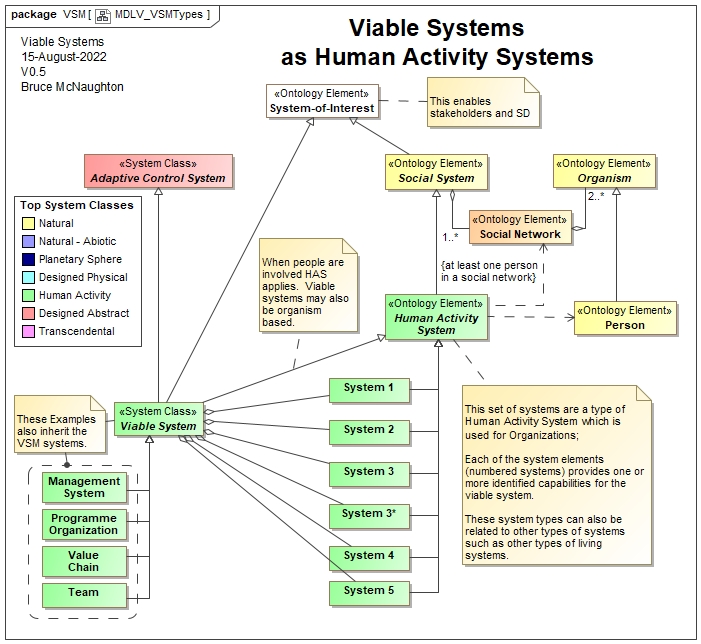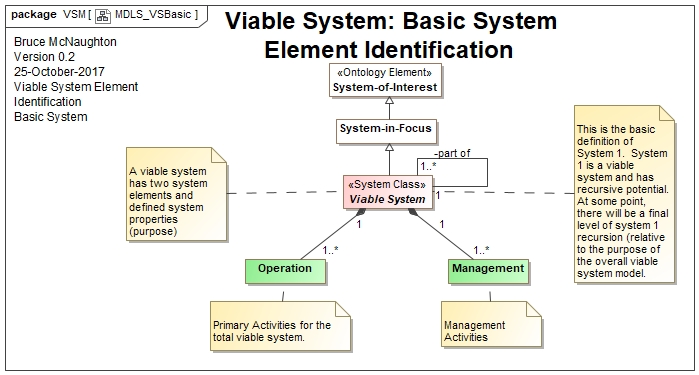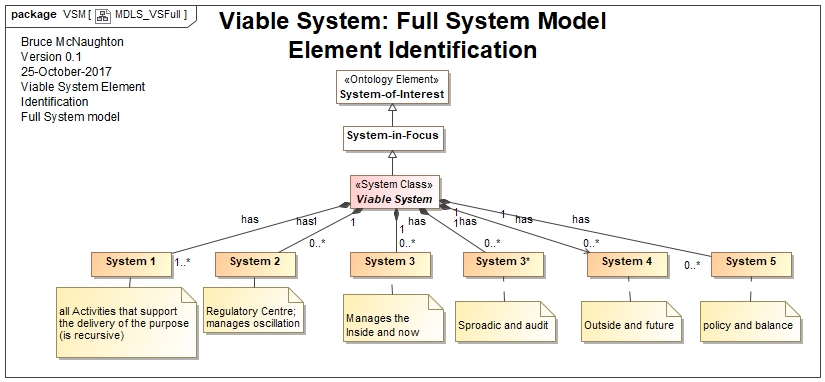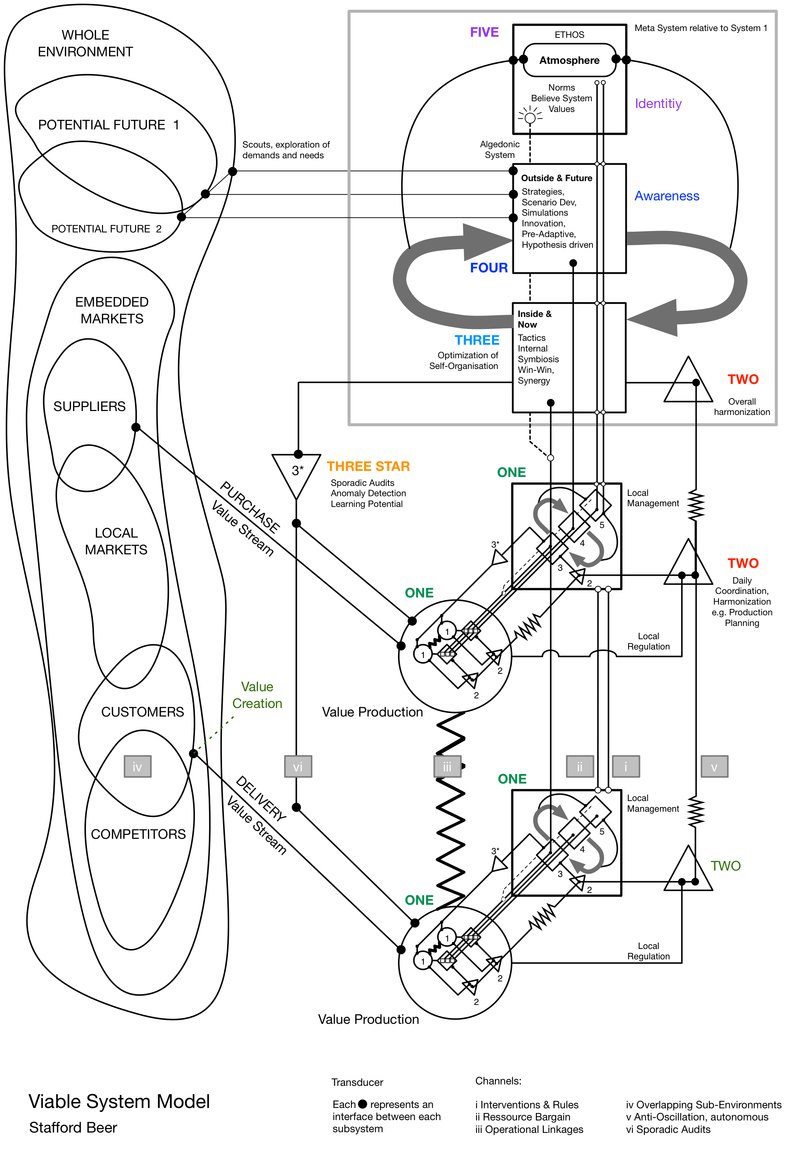Name: Viable System
Based on: System (Abstract) using Adaptive Control System pattern
Abstract System: This system has been identified as an abstract system that cannot be implemented directly. The abstract system establishes a shared pattern of characteristics that any system can use to describe its unique characteristics when referenced in the 'based on' list above. These references are described using a generalization association in UML.
Viable: means 'able to maintain a separate existence', The Oxford English Dictionary
An organization as a viable system is able to sustain it's own existence, grow and adapt in response to changes in the environment.
The following diagram provides classifications for the various systems in the viable system model for a human activity system (organization).

The viable system based upon the Viable System Model is a pattern that identifies a set of systems that represent a set of capabilities that are expected to be realized in a human activity system. This set of capabilities can be mapped on to any existing organization or help shape the capabilities of new organizations. This pattern can also be mapped to other types of living systems or designed systems.
Three references are available to understand the viable system:
- Diagnosing the System for Organizations, Stafford Beer
- Fractal Organizations, Patrick Hoverstadt
- Viable Systems Model, Wikipedia
The Viable System Model provides a way to look at the essential capabilities needed for an organization to be viable in the longer term.
The following examples of using the Viable System Model are:
The Viable System also fits nicely with the Russell Ackoff definition for a purposeful system:
An entity is purposeful if it can select both means and ends in two or more environments.
The purpose of a viable system as a system-of-interest is its reason for being. The purpose also relates to the functions and capabilities provided by the viable system (e.g. what the system does). The purpose is unique to each type of viable system seen as a system-of-interest.
Systemic Measurable Variables
The emergent properties created or used through the interaction of the elements. This includes both desired and undesired.
- Performance variables and their associated measurements
- High customer satisfaction and continued use
- Positive and motivating culture within the organisation
- Positive contribution to society and the economy
- Achieve the purpose of the Viable System
- Achieve performance objectives and targets
Systemic Capabilities or Functions
The capabilities or functions are produced through the work in system 1.
- Delivery of products and services
- Easily adapt to changes in the environment
- Development of suppliers capabilities to enable the organisation to meet its objectives.
System States
The various defined states that the Viable System can be in.
- Architectural states
- Transformational States
- Operational States
The way the organisation senses and responds to any of the emergent properties leading to undesired properties can determine the long term sustainability of the organisation.
Managers
- Will this organisation achieve its objectives and purpose?
- Is the organisation sustainable for the long term?
- Are our customers satisfied?
Team members
- Are the managers ensuring the long term viability of this organization?
- Will I be able to achieve my full potential in this organization?
The environment and the potential impacts on the Viable System.
this section includes
- The operational interface with the environment related to the current products and services (variety)
- The future environment looking at the longer term sustainability of the organisation
System Element: Identification

Each recursion then implements the full model where the full set of system elements are shown:
Full list of system elements and which are actually candidates for recursion.
There is a need to be very clear about the system-in-focus and the identification of those that deliver the organization's purpose.
The full model system elements are shown below:

System Element: Relationships
The relationships are shown in the top level viable system (operations and management) and then shown in the full Viable System Model. See Viable Systems Model, Wikipedia

Image from Wikipedia article. Link referenced above.
See the following PDF for examples of viable systems.
Configuration / Scenario:
Describes any configuration / scenario attributes for a specific system-of-interest. This may not be appropriate for all system descriptions (e.g. patterns or abstract systems).
Cyclical (Repeating / Regular) Processes
Typically the repeating / regular processes relate to the set of processes supporting the capabilities of the viable system. These processes form part of the management system established and implemented within a viable system.
Regular / repeating processes also include the audits and assessments conducted on a regular basis to test the effectiveness of the system. Minor corrective actions can be taken to improve performance.
See the Integrated Management System PDF for a list of the standards that can be used to establish capabilities..
Development Life Cycle Processes
The Viable Systems are created through the management practices in the viable system using the organizing activity of the manager. The management practices provide the ability to create the various systems and the overall structure of the resulting viable system.
Creating this viable system or management system uses a set of management capabilities and associated processes. See the examples for the types of capabilities that are generaly used and included.
The various models such as the VSM or the Management System requirements identify the capabilities that should be identified and designed through a viable system life cycle (typical life cycle is provided by ISO 15288:2015).. This system if established and implemented successfully will yield the following.
- Improved organizational maturity and culture
- Improved performance
- Improved ability to adapt and improve as a response to changes in the environment
- (NOTE: these are all viable system emergent properties).
The following references support this type of system-of-interest.
Book References
The Fractal Organization, Patrick Hoverstadt